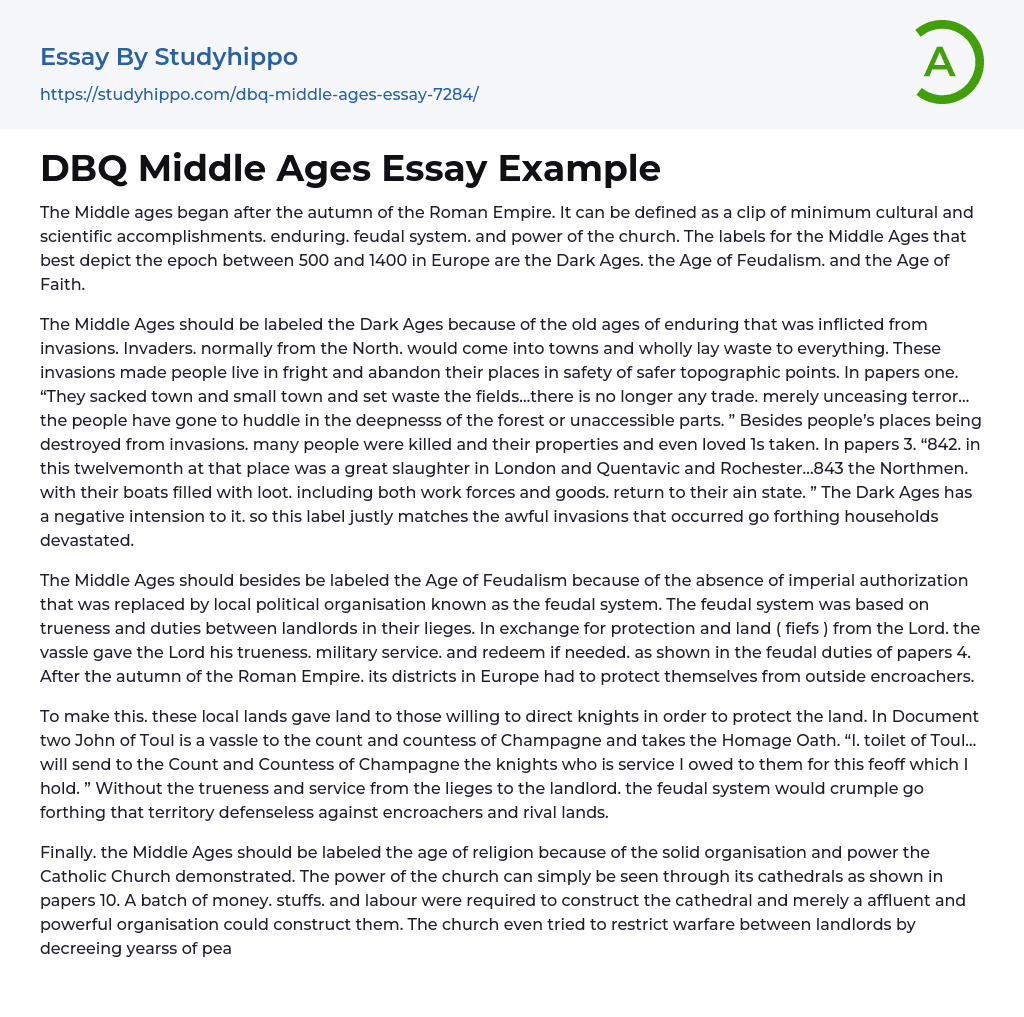The Middle Ages in Europe, which spanned from 500 to 1400, can be characterized as a period of limited cultural and scientific advancements, the presence of feudalism, and the influence of the church. This era is often referred to as the Dark Ages, Age of Feudalism, or Age of Faith. The term Dark Ages accurately depicts the extensive suffering caused by invasions from Northern regions that resulted in complete destruction of towns and forced people to flee their homes for safety. A document confirms widespread town devastation and constant terror as individuals sought refuge in secluded areas or dense forests due to their homes being destroyed. Another document recounts significant loss of life during 842 and 843 with a substantial carnage in London, Quentavic, and Rochester. These invaders known as Northmen returned home with stolen possessions and captives. Through its negative connot
...ation, the term "Dark Ages" effectively captures these devastating invasions that left families devastated along with property destruction.In addition to being known as the Age of Feudalism, the Middle Ages lacked central authority and instead operated under a local political system called feudalism. This social structure was based on loyalty and obligations between landlords and their subjects, known as vassals. Vassals pledged their allegiance, military service, and payment to their landlords in exchange for protection and land called fiefs. The feudal duties document 4 provides evidence of these obligations. Following the decline of the Roman Empire, European regions needed to defend themselves from external invaders. To achieve this, local lands granted land to individuals who would provide knights for defending the territory. Document two showcases John of Toul as a vassal of the coun
and countess of Champagne who takes an oath of homage. In his statement, he promises to provide knights for serving the Count and Countess in return for holding that specific land. Without subjects' loyalty and service towards landlords, the feudal system would crumble, leaving territories vulnerable to invasions from enemies and rival lands. Lastly, document 10 depicts the construction of cathedrals during this period known as the Middle Ages – a testament to the strong organization and influence exhibited by religion at that time.During the Middle Ages, building a cathedral required substantial resources such as funds, materials, and labor which were only accessible to the wealthy and powerful Catholic Church. To mitigate conflicts among landlords, the church implemented periods called Truce of God on specific days including Sundays, Fridays, Saturdays, and feast days. Within these designated times, violent acts like murder, arson, robbery, and assault were strictly prohibited. The Catholic Church enjoyed considerable power and influence over society during this time. This influence led some individuals to abandon their previous lives and join a cloistered order dedicated to serving God. A document showcases the vows taken by a brother who renounced his own will in favor of God's will and embraced the challenges of monastic life as evidence of this commitment. The church also demonstrated its authority through calling Crusades; Pope Urban II believed it was crucial for these campaigns to reclaim Christian lands that had been attacked and occupied by Turks and Arabs in the Middle East (Document 8). Document 9 illustrates both the spiritual and political control exerted by the church during this period. Overall, it is appropriate to describe the Middle Ages
not only as the Dark Ages but also as an Age of Feudalism and an Age of Faith.
The Middle Ages were characterized by a lack of cultural and scientific advancements, relying heavily on knowledge and wealth inherited from earlier civilizations. Document 6 represents this collection of wisdom and treasures from preceding eras. Despite facing struggles from invasions and feudal political organization, the Church's powerful influence over society could not be escaped, thus preventing it from being considered a golden age (Document 7). Additionally, Document 7 suggests that medieval culture was limited to a small group of intellectuals. To fully comprehend the restricted cultural and scientific progress during this era, another document detailing its accomplishments would be beneficial for comparison to other civilizations' achievements during their own Golden Ages.
- Baptism essays
- Holy Spirit essays
- Jesus Christ essays
- Adam And Eve essays
- Crucifixion Of Jesus essays
- Crusades essays
- Eucharist essays
- God The Father essays
- Pope essays
- Protestantism essays
- Christian essays
- Church essays
- Elizabeth essays
- Sacrament essays
- Catholic Church essays
- Lord essays
- Priest essays
- Protestant Reformation essays
- Afterlife essays
- Atheism essays
- Bible essays
- Buddhism essays
- Christian Worldview essays
- Christianity essays
- Confession essays
- Cosmological Argument essays
- Deism essays
- Devil essays
- Existence of God essays
- Faith essays
- Freedom Of Religion essays
- God essays
- Hinduism essays
- Immortality essays
- Islam essays
- Jainism essays
- Jews essays
- Judaism essays
- Miracle essays
- Monk essays
- Monotheism essays
- New Testament essays
- Old Testament essays
- Pilgrimage essays
- Puritans essays
- Revelation essays
- Ritual essays
- Salvation essays
- Sin essays
- Sinners essays




